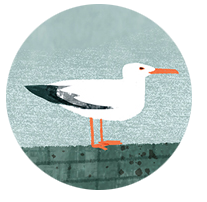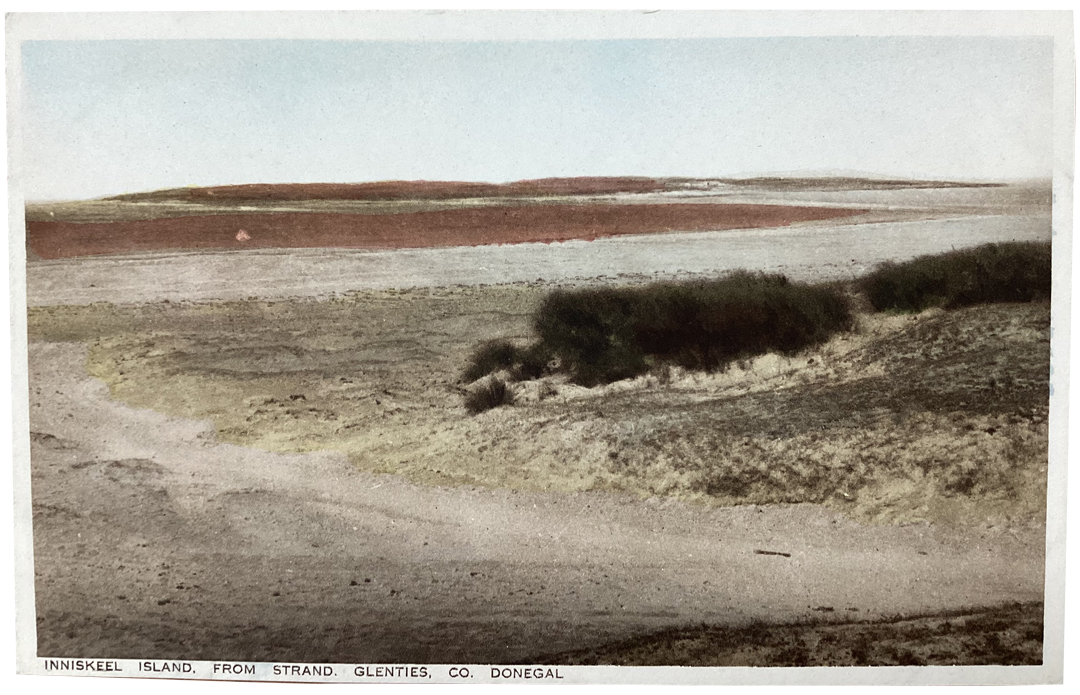
The stone-work is grained with yellow and grey lichen. It begins stage left (the mainland) and juts out into the sea so that it is surrounded by water on three sides.
From the floor of the pier stone steps lead down to the sea/auditorium. One can see over the back wall of the pier and right across the surrounding countryside and sea.
There are some weather-bleached furnishings lying around the pier floor: fragments of fishing-nets, pieces of lobster-pots, broken fish-boxes. Some rusty bollards and rings. A drift of sand in the top right-hand corner. Stones once used as weights inside lobster-pots. A listing and rotting wooden stand, cruciform in shape, on which hangs the remnant of a life-belt.
A stone pier at the end of a headland on the remote coast of north-west Donegal.
TRISH: Very… remote, isn’t it?… You’d think you could see beyond the horizon. It really is wonderful. Oh my goodness… Ballybeg pier. In County Donegal.
![]()
FRANK: Or maybe we’ve got it all wrong as usual, Terry. Maybe Saint Conall stood on the shores of the island there and gazed out across here at Ballybeg, and said to his monks, ‘Oh, lads, lads, there is the end of desire.’
![]()
FRANK: And not only is there no boat, there isn’t a house within a hundred miles of us… Nothing but bogland from here to the horizon.
![]()
TERRY: A thatched cottage further to your left… Carlin’s the name… Someone from that house will take us, Frank. They’ve been ferrying people for thousands of years.
![]()
TRISH: Where are we, Terry
FRANK: Arcadia
TERRY: Ballybeg pier – where the boat picks us up.
![]()
STAGE DIRECTION: The pier is lit by a midsummer night glow that illuminates with an icy, surreal clarity. The boisterous, day-excursion spirit has long evaporated. Waiting for the boat has made them weary and a bit irritable. Each has retreated into his/her own privacy and does not wish to be intruded on.
St Conall’s monastery on Inishkeel Island at Portnoo
TERRY: I was there just once with my father. I was only seven at the time. We fasted from the night before, I remember. And for the night you were on the island you were given only bread and water. There were three beds – you know mounds of stone – and every time you went round a bed you said certain prayers and then picked up a stone from the bottom of the mound and placed it on top.
![]()
And I remember a holy well, and my father filling a bottle with holy water and stuffing the neck with grass – you know, to cork it. And I remember a whin bush beside the well. And there were crutches and walking-sticks hanging on the bush; and bits of cloth – bratóga, my father called them – a handkerchief, a piece of a shawl – bleached and turning green from exposure. Votive offerings – isn’t that the English word? And there’s the ruins of a Middle Age church dedicated to Saint Conall.
TERRY: There is a legend that it was once a spectral, floating island that appeared out of the fog every seven years and that fishermen who sighted it saw a beautiful country of hills and valleys, with sheep browsing on the slope, and cattle in green pastures, and clothes drying in hedges. And they say they saw leaves of apple and oak and heard a bell and the song of coloured birds. Then, as they watched it, the fog devoured it, and nothing was seen but the foam swirling on the billow and the tumbling of the dolphins.
![]()
BERNA: Island of Otherness; Island of Mystery.
TRISH: God, it’s not spooky, Terry, is it?
BERNA: Not that kind of mystery. The wonderful – the scared – the mysterious – that kind of mystery.

BRIAN FRIEL: And I used a song called ‘Down by the cane break’ in a play called Wonderful Tennessee because it was a song my mother sang; and because the words of the song – the promise of happiness in the Eden of Tennessee – those words echo the theme of the play.
Down in De Cane Break, Frank Crumit, 1928
BERNA: ‘Down by the cane brake, close to the mill
There lived a blue-eyed girl by the name of Nancy Dill –
TERRY: Mother’s song.
BERNA: ‘I told her that I loved her, I loved her very long,
I’m going to serenade her and this will be my song –‘
Come, my love, come, my boat lies low,
She lies high and dry on the O-hi-o.
Come, my love, come, and come along with me
And I’ll take you back to Tennessee.’
Places of pilgrimage in Donegal
Lough Derg, Doon Well, Kerrytown, Inishkeel island.
15/ 16 November 1983
A Lough Derg play would be concerned primarily with mystical-symbolic notions of pilgrimage.
29 June 1990
Drove to Doon Well yesterday afternoon. Not at all the place I remembered. Parking spaces for buses and cars. Toilets. The house (Gallaghers) well-kept and prosperous. The well itself more formal than I remembered. And beside it the bush with the bratóga, looking tawdry and soiled – the rags turning green with age and exposure. A sudden sense that the play has found a foot-hold. Pilgrims. Words. Panic. Fun. Belief. Words. Experience. Joy. Words.
9 August 1990
And now a new location. An old stone pier. Facing the island. The island is now the mystery, the aspiration. The boatman – the bridge between the pain and the mystery – will be discovered within each person before the play ends… The boatman’s name is MacLoone.
17 August 1990
I can’t begin until I’ve decided whether the play is on the sacred place (island, Kerrytown, Inishkeel, wherever) or on the pier looking out to the island.
19 August 1990
The island is two things: a physical place out there in the sea, with a name, contours, hills, ruins, a well. It’s also a condition of the mind, an aspiration, a desire, a longing that can’t be assuaged.
11 Dec 1991
A key moment in the play is when one of the pilgrims (Bernadette?) begins making a ‘station’.
30 June 1990
I dreamed of the play last night. An open place. Lots of people. Pilgrims doing their stations.
13 July 1990
The atmosphere must be joyous, holiday, outgoing, excursion – a day away.
31 July 1990
If the storytelling technique is used: could it be the night of the vigil? No sleep – no food – and consequently a kind of giddiness; a sense of close comradeship… but it has something to do with lifting the burden of life, with – as they might say themselves – with experiencing ‘happiness’, with release. Can I subject that dreamt landscape to a precise geography?
✭ Wonderful Tennessee, Book Jacket, courtesy of The Gallery Press
✭ Postcards of Donegal, Courtesy of Donegal County Museum
✭ Sketch. National Library of Ireland Collection List No. 73 BRIAN FRIEL PAPERS, MS 37,793 /1 – 5: Series of pastel sketches of the cast by John Ryan sent to Friel ‘to remember the rehearsals and the lead-up to the staging of ‘Wonderful Tennessee!’
✭ Photo of Friel and Vanek on Greencastle Pier. National Library of Ireland Collection List No. 73 BRIAN FRIEL PAPERS, MS 37,793 /1 – 5: Joe Vanek: colour photograph of himself and Friel
✭ Images of objects from The Laurels – holy water bottle and brooch, Donegal County Council Heritage Office.
✭ Down in De Cane Break, Frank Crumit, 1928. Courtesy of OldiesAl
✭ Wonderful Tennessee (1993) by Brian Friel (County Meath: Gallery Books) 1993
✭ Seven Notes for a Festival Programme (1999), in Murray, Christopher (ed.) Brian Friel: Essays, Diaries, Interviews: 1964-1999. London: Faber& Faber, 1999, p. 176-7
✭ Courtesy of the National Library of Ireland
✭ National Library of Ireland Collection List No. 73 BRIAN FRIEL PAPERS, MS 37, 123/2 Wonderful Tennessee. Typewritten diary entries on the genesis of the play, made between 27 June 1990 and 14 May 1991 and 11, 16 & 17 December 1991. June 1990 − May & Dec 1991. 31pp.

An Action of the County Donegal Heritage Plan
© 2024 | Donegal County Council. All rights reserved.